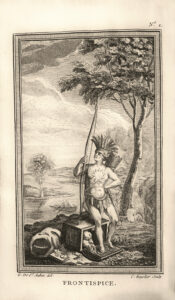Paris, Le Jay, 1768.
2 parts in 1 volume, 12mo: pp. xx, 244; title, 264 pp. 4 plates. Marbled calf, spine with raised bands richly gilt, red edges. Contemporary binding.
163 x 94 mm.
Rare first edition illustrated with two frontispieces and 2 full-page plates by Saint Aubin engraved by Beurlier.
Howgego I,138(B138); Sabin 6465; JCB I (III-I) 1611; Howes B626; Streeter 15187; Clark, Old South II, 5; Field 156; Rader 408; Monaghan 261; Hubach p. 13; Storm, De Graff 361; Eberstadt 131:84; Siebert 677; Leclerc I, 185. Cf. Servies, Florida 491: the English edition of 1771.
“Le Chevalier Bossu est un de ceux qui ont le mieux fait connaître la Louisiane, et les peuples sauvages qui l’habitaient. Il fut envoyé dans ce pays en 1750, et nommé à cette époque Capitaine de la Marine…” (Chadenat 23).
First edition, of primary interest for Louisiana, Alabama, Illinois, and West Florida.
Jean Bernard Bossu (1720–1792), a captain in the French navy, was the first to write in detail and from personal experience about eighteenth-century Louisiana. He provided the French public with the earliest reliable account of the people and conditions in the colony. The work is in fact a collection of 21 letters written during his first two voyages to the region, from 1751–57 and 1757–62. Bossu traveled as far north as Fort de Chartres, just south of Saint Louis. He spent time among the Natchez, Arkansas, Koakias (Cherokees?), Alabama, Choctaw, Illinois, and Atakapa tribes, offering substantial detail on their religious practices, warfare, social customs (e.g., punishment for adultery), hunting, and more. He also comments on Santo Domingo, mining, syphilis, Havana, New Orleans, Hernando de Soto, El Dorado, the Sieur de La Salle, Granada, Jamaica, Lake Ponchartrain, Mobile, and the Fountain of Youth. At times, he ranges even farther afield, describing, for example, the skeletons of elephants (i.e., mastodons) found in the Ohio Valley in 1735 (p. 206). Indirectly, he reports on Canadian events such as Montcalm’s capture of Fort Oswego, Fort Ontario, and New Fort Oswego in 1756. In Book II, Letter XXI, Bossu speculates that the Indians reached America via a land bridge from Tartary, referencing the works of Diodorus Siculus, Peter Martyr, Lafitau, Lescarbot, and Bering. During his travels, Bossu was shipwrecked, narrowly escaped a crocodile, and was harassed several times by English privateers. The four engravings by Gabriel de Saint Aubin all depict Indigenous people; among them are a gruesome decapitation scene and an Indian standing atop an overturned chest full of coins. The first edition is distinguished from the second (issued with the same imprint and date) by the absence of the words “second edition” on the title page. Howes notes: “For comments too critical of the ministry, Bossu was imprisoned and his book banned for a while in France; this probably accounts for the scarcity of the first edition, of which Sabin found no record.” The Nouveaux voyages was soon translated into English, Dutch, German, and Russian.
A fine copy in contemporary binding.

![Nouveaux voyages aux Indes Occidentales ; Contenant une Relation des differens Peuples qui habitent les environs du grand Fleuve Saint-Louis, appellé vulgairement le Mississipi ; leur Religion, leur gouvernement, leurs mœurs [sic] ; leurs guerres & leur commerce. Par M. Bossu, Capitaine dans les Troupes de la Marine.](https://www.camillesourget.com/wp-content/uploads/2025/07/DSC_3950-scaled.jpg)
![Nouveaux voyages aux Indes Occidentales ; Contenant une Relation des differens Peuples qui habitent les environs du grand Fleuve Saint-Louis, appellé vulgairement le Mississipi ; leur Religion, leur gouvernement, leurs mœurs [sic] ; leurs guerres & leur commerce. Par M. Bossu, Capitaine dans les Troupes de la Marine. - Image 2](https://www.camillesourget.com/wp-content/uploads/2025/07/DSC_3951-scaled.jpg)
![Nouveaux voyages aux Indes Occidentales ; Contenant une Relation des differens Peuples qui habitent les environs du grand Fleuve Saint-Louis, appellé vulgairement le Mississipi ; leur Religion, leur gouvernement, leurs mœurs [sic] ; leurs guerres & leur commerce. Par M. Bossu, Capitaine dans les Troupes de la Marine. - Image 3](https://www.camillesourget.com/wp-content/uploads/2025/07/DSC_3952-scaled.jpg)
![Nouveaux voyages aux Indes Occidentales ; Contenant une Relation des differens Peuples qui habitent les environs du grand Fleuve Saint-Louis, appellé vulgairement le Mississipi ; leur Religion, leur gouvernement, leurs mœurs [sic] ; leurs guerres & leur commerce. Par M. Bossu, Capitaine dans les Troupes de la Marine. - Image 4](https://www.camillesourget.com/wp-content/uploads/2025/07/DSC_3954-CUT-scaled.jpg)
![Nouveaux voyages aux Indes Occidentales ; Contenant une Relation des differens Peuples qui habitent les environs du grand Fleuve Saint-Louis, appellé vulgairement le Mississipi ; leur Religion, leur gouvernement, leurs mœurs [sic] ; leurs guerres & leur commerce. Par M. Bossu, Capitaine dans les Troupes de la Marine. - Image 5](https://www.camillesourget.com/wp-content/uploads/2025/07/DSC_3954-scaled.jpg)
![Nouveaux voyages aux Indes Occidentales ; Contenant une Relation des differens Peuples qui habitent les environs du grand Fleuve Saint-Louis, appellé vulgairement le Mississipi ; leur Religion, leur gouvernement, leurs mœurs [sic] ; leurs guerres & leur commerce. Par M. Bossu, Capitaine dans les Troupes de la Marine. - Image 6](https://www.camillesourget.com/wp-content/uploads/2025/07/DSC_3958-scaled.jpg)
![Nouveaux voyages aux Indes Occidentales ; Contenant une Relation des differens Peuples qui habitent les environs du grand Fleuve Saint-Louis, appellé vulgairement le Mississipi ; leur Religion, leur gouvernement, leurs mœurs [sic] ; leurs guerres & leur commerce. Par M. Bossu, Capitaine dans les Troupes de la Marine. - Image 7](https://www.camillesourget.com/wp-content/uploads/2025/07/reliureCUT-scaled.jpg)